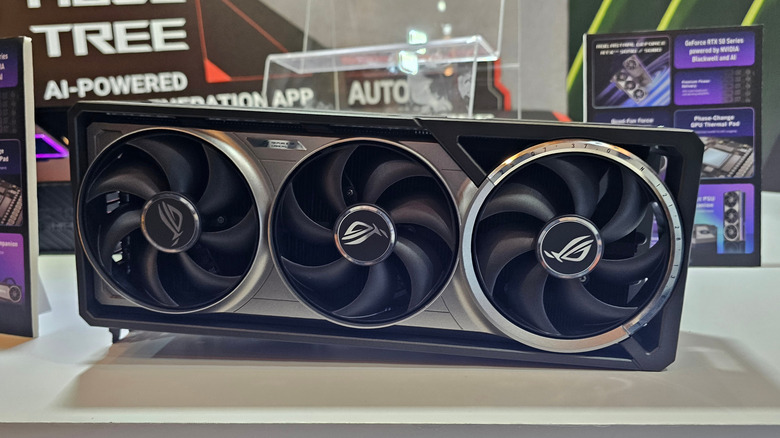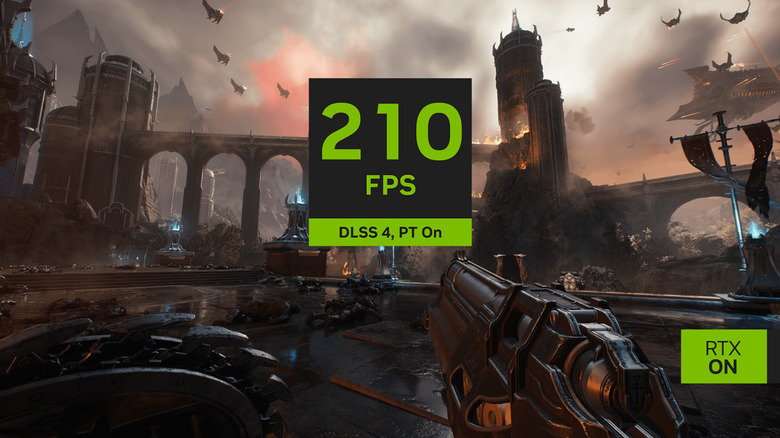What Does 'DLSS' Mean On An Nvidia Graphics Card?
Nvidia makes some of the most revered graphics cards on the market, and these peripherals are one of the most essential parts of a great PC gaming experience. If you've been shopping around for a new GPU for your custom desktop rig, and you've considered one or several Nvidia models, there's a good chance you've seen the letters "DLSS" stamped on an Nvidia box or featured on a website listing.
DLSS stands for Deep Learning Super Sampling, an in-house image enhancement and scaling technology that Nvidia released in 2019. Powered by Nvidia's neural network, you'll only find DLSS built into Nvidia's RTX series of graphics cards. There are more than 300 games that support this AI performance tool, and Nvidia has been consistently upgrading the technology since its inception.
At its core, DLSS is Nvidia's take on temporal anti-aliasing up-sampling (TAAU), an image technology that uses sub-pixel variations from older frames to add detail and to cut down on image aliasing. DLSS allows supported games to look sharper and run smoother.
The evolution of DLSS, from early upscaling to multi-frame AI
From one DLSS generation to the next, Nvidia has been making it simpler for PC gamers to enjoy a more robust graphics experience. The technology puts less strain on the GPU by placing the brunt of the image enhancements and upscaling on AI. Using lower-resolution frames as a foundation, Nvidia's neural network adds in the missing details, resulting in a final image that's near-identical to a supported game's native resolution.
When DLSS was first released, it was an exclusive feature for Nvidia's RTX 20 series that only supported two games. But when DLSS version 2 hit the scene, Nvidia started using AI to push its TAAU refinements into a wider breadth of games, by way of Tensor Cores built into the Nvidia RTX lineup.
DLSS version 3 introduced a new algorithm that doubled the refresh rate for the Nvidia RTX 40 series, while version 3.5 added ray tracing capabilities. This replaced version 3's algorithm with an expansive AI model trained on a much larger data set. And with the rollout of DLSS version 4 (featuring Multi Frame Generation) on the RTX 50 series, DLSS can now interpret several frames at once to create an even sharper and smoother gaming experience.
Balancing performance and visuals with DLSS
Graphically demanding PC games are a thrill to play, especially when your GPU and other PC peripherals are operating on all thrusters to deliver seamless visuals. As of the publication of this article, Nvidia's DLSS 4 standard is supported by more than 125 games, including popular titles like "Doom: The Dark Ages" and "Dune: Awakening."
PC gamers will be able to manually adjust DLSS settings for all supported titles by heading to the game's graphics menu. There will typically be three or four DLSS presets to choose from — including Quality, Balanced, and Performance — with additional graphics optimizations available for certain games.
You may find that one game performs best with DLSS taking the lead on the graphics, while other titles may look and feel better with lower DLSS settings. You might even want to bypass DLLS entirely by choosing DLAA (Deep Learning Anti-Aliasing), which shifts the focus from upscaling to visual improvements based on your game and monitor's native resolution.


